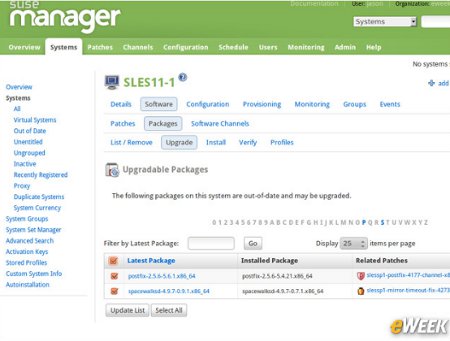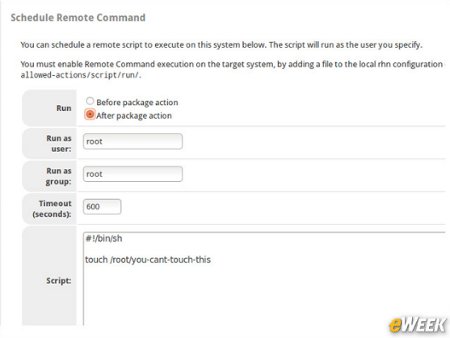SUSE Manager 1.2 offers tuxy take on server management
May 5, 2011 — by LinuxDevices Staff — from the LinuxDevices Archive — 3 viewsNovell's new Spacewalk-based SUSE Manager 1.2 deserves points for its support of both SUSE and Red Hat enterprise Linux flavors, says this eWEEK review. But, author Jason Brooks adds, while the server management tool makes sense for users coming from a Linux perspective, it suffers from some configuration hiccups, due in part to the challenge of integrating two different distributions.
Novell's SUSE Manager 1.2 provides users of the company's enterprise-oriented Linux-based operating systems with a server-management tool built from the ground up with Linux in mind.
SUSE Manager, which began shipping in March, is based on Spacewalk 1.3, an open source project born out of Red Hat's own server-management product, Satellite, whose code Red Hat freed in 2008. Pricing maps very closely to what Red Hat charges for its Satellite product (see end of story).

SUSE Manager 1.2 web console
(Click to enlarge)
I tested SUSE Manager 1.2 with test servers running SLES 11 SP1 and with RHEL 6. Once I had everything set up correctly, the product worked as advertised. On my test systems, I used SUSE Manager to conduct software installation and update tasks, push down configuration changes, and monitor services running on the machines. The product can also handle system provisioning, a feature that I did not test.
En route to these results, I spent quite a bit of time wrestling with mirror credentials between Novell's Customer Center and my SUSE Manager installation. It's tough to tell exactly how much of these difficulties to pin on SUSE Manager and how much to pin on the back-end services. However, there's certainly room for improvement here — if only to ease the process of evaluating the product for a potential move from Red Hat to Novell for support.
Among the other rough edges I encountered were the at-times-confusing references to Red Hat throughout the product, some of which weren't clearly spelled out in the documentation. For instance, in the documentation for setting up configuration file management, there's a spot that refers to mgrcfg-client, an application that I found on my SLES 11 test machine, but on my RHEL 6 machine, the application was called rhncfg-client.
For SLES customers, SUSE Manager is well worth evaluating. Although SLES and RHEL are different products, they have quite a bit in common, and it makes sense for Novell to throw in its lot with Red Hat to address those issues. It's not clear to me just how enticing a move from Red Hat to Novell for RHEL support would be, but having the option can't hurt.
Testing SUSE Manager 1.2
I installed SUSE Manager on a virtual machine running on VMware vSphere; the product came on an ISO image bundled with a copy of SLES 11. SUSE Manager ships with a built-in Oracle XE database, which I used for my tests.
In a production environment, Novell recommends using a full-sized version of Oracle 10g or 11g. The dependency on Oracle as a database back-end comes from Red Hat, which opted for Oracle in the early days of RHN and hasn't yet severed that requirement.
The upstream Spacewalk project has partial support for PostgreSQL as an alternative to Oracle, but this support isn't yet complete. After installing the server, I configured software-update channels for SLES 11 and for RHEL 6.
It took a bit of bouncing back and forth with my contacts at Novell to get the credentials and entitlements straight for these products. First, with the SLES software channel, and later, with the RHEL channel, I was able to subscribe my SUSE Manager server to the channels I needed, but the packages weren't synchronizing correctly. Once we got the subscriptions straight, however, they worked as expected.
I spun up a pair of VMs, one running SLES 11 SP1, and the other running RHEL 6, and registered each system with my SUSE Manager installation, which involved configuring and running a bootstrap script on each system. Both of my test machines retained their standard software installation tools — for RHEL, yum, and for SLES, zypper. Both tools fetched their packages from SUSE Manager.
For my RHEL system, I had to supplement the packages available through SUSE Manager with a repository that I had to build from the RHEL 6 install media. I believe that I could have integrated this repository with the SUSE Manager, but it wasn't clear from the documentation how to do this, so I left it separate. Neither SUSE Manager nor my test RHEL client complained about using packages from separate sources.
I updated my SLES and RHEL systems with the latest packages available, and installed some new software on both systems through the SUSE Manager web interface. I was also able to run arbitrary remote commands on these systems through the same web console (see image below).

Scheduling remote commands
(Click to enlarge)
I also dipped into SUSE Manager's system-monitoring capabilities, but with mixed success. I added a simple SNMP-based uptime probe to my systems, along with a directive to report to me via email.
This probe worked as expected, but I couldn't manage to get a second Apache uptime-specific probe to work. Instead, I received, from both my SLES and RHEL machines (each of which, I confirmed, were in fact running working instances of Apache) a string of error emails with the unhelpful message: "Internal problem executing check. Please contact Red Hat."
I'm looking forward to spending more time with SUSE Manager's upstream open source project, Spacewalk. In particular, I plan to test the project's support for Debian-based distributions and for PostgreSQL as a database back end.
Attachmate layoffs at Novell
In related news, following Attachmate's completed acquisition of the company last week, there have been reports of hundreds of layoffs at Novell, including layoffs at Novell's Mono project. Yesterday, there were reports that the Mono project was shut down entirely, but apparently no definitive evidence. Meanwhile, others have speculated that Attachmate will not be investing much effort in SUSE Linux, which has been spun off as a separate unit to be run out of the Nuremberg, Germany office.
Further information
Pricing for SUSE Manager starts at $13,500 for the core server, and $2,500 for proxy server nodes. Individual SUSE Manager modules start at $96 per managed server. More pricing information is available here. SUSE Manager and its components may be freely downloaded and used for a 60-day evaluation.
An eWEEK slide shown on SUSE Manager 1.2 may be found here.
Jason Brooks is Editor-in-Chief for eWEEK Labs.
This article was originally published on LinuxDevices.com and has been donated to the open source community by QuinStreet Inc. Please visit LinuxToday.com for up-to-date news and articles about Linux and open source.